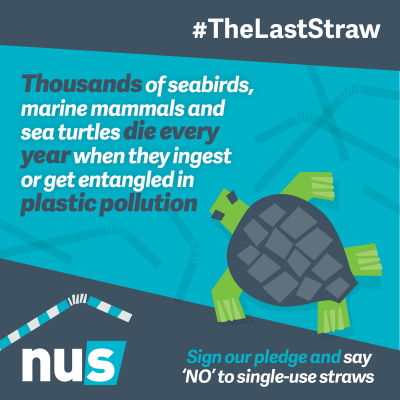LEAP #1: Anti-Straw Campaign
- deborahsareth

- May 7, 2019
- 3 min read
Updated: May 8, 2019
"Universal literacy was supposed to educate the common man to control his environment...Instead of a mind, universal literacy has given him rubber stamps, rubber stamps inked with advertising slogans, with editorials, with published scientific data...but quite innocent of original thought. Each man's rubber stamp are the duplicates of millions of others, so that when those millions are exposed to the same stimuli, all receive identical imprints. [Bernays, pg. 20]."
The first three images are examples of contemporary propaganda shown on the Mind over Media website, followed by indistinguishable and related images regarding the Anti-Straw Campaign/Movement. Each image providing its own propaganda, but they're like a carbon copy [pun-intended] of the previous one.
"It may seem an exaggeration to say that the American public gets most of its ideas in this wholesale fashion. The mechanism by which ideas are disseminated on a large scale is propaganda." [Bernays, pg. 20].
Shown below is a viral video of a sea turtle with a straw up its nostril, taken from National Geographic. Due to it's graphic imagery and activation of emotions, it remains an important catalyst in the Anti-Straw Movement. It also contributes to the virality of the movement, by shares and likes on social media platforms.
CRITICAL QUESTIONS:
1. The author of the example of contemporary propaganda that I chose is Greenpeace, Canada, specifically their #breakfreefromplastic campaign, which is "a global movement envisioning a future free from plastic pollution. Since its launch in 2016, nearly 1,500 organizations from across the world have joined the movement and demand massive reductions in single-use plastics and to push for lasting solutions to the plastic pollution crisis." The campaign itself is titled, "don't suck the life from our oceans."
2. Within the past year the Anti-Straw Movement has garnered both attention and traction through the use of the viral sea turtle video, and social media. Large corporations such as Starbucks and Burger have hopped on board the bandwagon. "Starbucks announced earlier [this month] its plan to phase out single-use plastic straws by 2020, replacing them with a lid where straws are unnecessary. In September, Burger King U.K. will use biodegradable straws in its restaurants and stateside." [Corr, July 2018].
3. Although the campaigns singles out straws as harmful, I believe the purpose of this propaganda is to bring awareness towards the plastic pollution issue as an entirety. "Greenpeace Canada looks to draw attention to the ill effects of throwaway plastic in general, including cups and lids." [Corr, July 2018].
4. The "Don't suck life from our oceans" example of contemporary propaganda targets multiple audiences: concerned environmentalists, those concerned about the well-being of our wildlife, and users of social media who may come across the campaigns imagery accidentally.
5. To answer this question I have to agree with a comment left behind on the Mind Over Media Website.

6. As the comment left by Robert alludes, activation of emotions: such as guilt, disgust, sympathy, and the like is the persuasive strategy used in the images. It is evident in this comment left on the Mind over Media website.

7. The lifestyle that is represented is the lifestyle of an unchanging single-use plastic user. While the value of environmental and wildlife preservation is represented; and a point of view that plastic pollution is an major concern that should not be ignored or taken lightly. For fear of consequences or repercussions.
8. Different people might interpret the message in a variety of ways. Many may be similar to NayNay, where guilt and disgust override any rationale. Some may be educated enough to dissect the propaganda for what it is, like Robert. And still some may be indifferent to the imagery. People may share the propaganda just to share it, and not take any initiative to change their individual behaviors. That is the virality part of this piece of propaganda, especially with the sea turtle video.
9. Statistics and scientific data is omitted in this particular example of propaganda. But perhaps the author felt that the imagery was strong enough to sway opinions.
10. For those who care about the environment, (sympathetic towards) wildlife, waste management, and their own carbon footprint, these individuals may see this as beneficial. For those non-believers in climate change, this would be considered harmful. Especially with the emergence of very similar Anti-Straw campaigns within the past few years.
references:
"#breakfreefromplastic". (2019, April 03). About. Retrieved from https://www.breakfreefromplastic.org/about/
Anti- Straw. (n.d.). Retrieved from https://propaganda.mediaeducationlab.com/rate/anti-straw
Bernays, E. (2010). Propaganda. Retrieved from http://www.whale.to/b/bernays.pdf
Corr, A., & Corr, A. (2018, July 31). This Campaign Shows How Your Plastic Straws Suck the Life Out of Ocean Animals. Retrieved from https://www.adweek.com/creativity/this-campaign-shows-how-your-plastic-straws-suck-the-life-out-of-ocean-animals/
Lee, J. J. (2018, June 05). How Did Sea Turtle Get a Straw Up Its Nose? Retrieved from https://www.nationalgeographic.com.au/animals/how-did-sea-turtle-get-a-straw-up-its-nose.aspx

















Comments